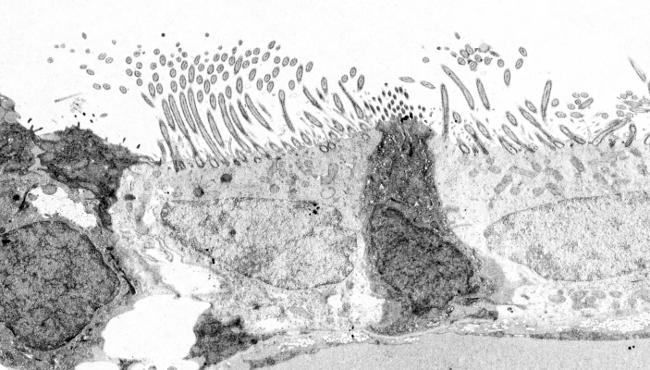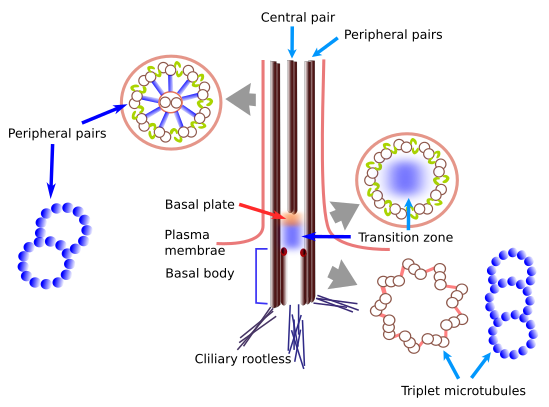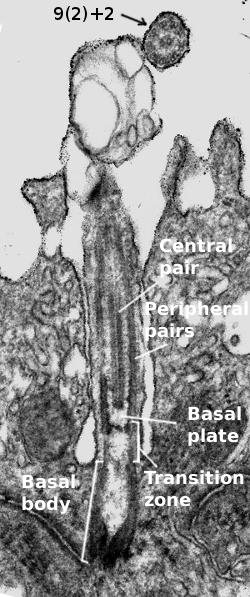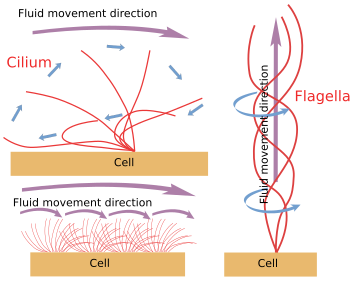Microtubules are cytoskeleton components with important functions in cell physiology. The microtubule scaffold of the cytoplasm is highly plastic thanks to the polymerization and depolymerization capacity of microtubules. However, not all cell microtubules are under this shrinking or growing stages. Cilia, flagella and centrioles/basal bodies are cellular structures containing very stable (number and length) and highly organized microtubules. In this page we are dealing with cilia and flagella.
1. Cilium
Cilia are thin and long cell protrusions of about 0.25 µm in diameter and about 10 to 15 µm in length, which can be found in animal cells and some unicellular eukaryotic species. They are usually tightly packed at the free surface of epithelial cells (Figures 1 an 2), such as the epithelium of the respiratory tracts, epithelium of reproductive ducts, gills of fish and bivalves, etcetera. Cilia are motile structures and their main function is to move the surrounding liquid, like the mucus of the respiratory tract surface, water around gill epithelium, but also the oocyte in the female Fallopian duct. Many unicellular organisms can move propelled by cilia, and others can use them for generating water swirl for catching food. Embryo nodal cilia have been implicated in initiating the left–right axis during embryonic development of vertebrates. Cilia movement is like beating, which impulses the liquid parallel to the cell surface.

Figure 1. Scanning electron microscopy images showing the central canal of a lamprey spinal cord. Many cilia can be observed (at higher magnification in B) and small microvilli at the apical domain of ependimal cells.

Figure 2. Transmission electron microscopy images of the respiratory epithelium. Cells with clear cytoplasm show many cilia in their apical surface.
There are cilia that cannot move, and therefore they are not intended for liquid movement. These cilia are known as primary cilia. Most cells study so far (excepting red blood cells) bear primary cilia: oviduct cells, neurons, chondrocytes, ectoderm cells, mesenchymal cells, urinary epithelial cells, hepatocytes, and even cultured cells. Initially, primary cilia were though as non-functional cilia. However, many receptor types and ion channels were found the ciliary membrane, so they were regarded as cell sensory structures. For example, olfactory receptors are found in cilia of their dendrites, and the external segments of rods and cones of the retin are actually modified cilia. Some receptors are more highly packed in the ciliary membrane than in other plasma membrane domains. In addition, there is a wide variety of molecules in the interior of the cilia involved in signal transduction roles. The higher surface/volume ratio of a cilium makes intraciliary molecular responses more intense and efficient than if it were outside the cilium. Besides chemical signal, primary cilia may detect fluid movement outside the cell and work as mechanoreceptors.
2. Flagellum
Flagella are similar to cilia, but they are much longer, about 150 µm long, and slightly thicker. They are quite less numerous than cilia in cells. The main function of flagella is to move the cell. The flagellum movement is different from that of cilium because the movement direction is perpendicular to the cell surface (not parallel), that is, the direction of the longitudinal axis of the flagellum. Flagella can be frequently observed in motile cells like unicellular organisms and sperm.
3. Structure
Cilia and flagella are complex structures containing more than 250 different proteins. Both share the same central microtubule organization and other associated proteins, altogether known as axoneme, and limited by plasma membrane (Figure 3). Besides axoneme, there are many soluble molecules inside the cilia/flagella constituting the matrix. Axoneme is made up of 9 pairs of microtubules around another central pair of microtubules. This organization can be writen as (9 x 2) + 2. Primary cilia lack central pair of microtubules. Each microtubule of the central pair is made up of 13 protofilaments, but microtubules of the peripheral pairs share some protofilaments between each other. Thus, a peripheral pair is formed by A and B microtubules. The A microtubule contains 13 protofilaments and B microtubule contains 10 or 11 protofilaments, sharing 2 or 3 with A microtubule.

Figure 3. Main molecular components of cilia and flagella. In primary cilia, the central pair is absent.
The microtubule organization of the axoneme is the result of a scaffold of proteins. Twelve proteins have already been found as constituents of the axoneme involved in maintaining microtubule organization. The neighbor peripheral microtubule pairs are connected between each other by nexin. In each pair, the A microtubule is connected by protein spokes to a central ring that contains the central pair or microtubules. Dinein is a motor protein associated to the peripheral microtubules involved in the movement of cilia and flagella.

Figure 4. Ultrastructure of a cilium of an ependimal cell of the spinal cord. (9+2)x2 means 9 peripheral pairs and 1 central pair of microtubules.
Microtubules are polymerized from basal bodies (Figures 3 and 4). Basal body is made up of 9 triplet microtubules forming a cylinder (similar to centrioles). They lack a central pair of microtubules, so it is (9x3)+0. In each triplet, only one microtubule (A microtubule) has a complete set of protofilaments, whereas B and C microtubules share some of them between each other. From the basal body, A and B microtubules grow and form the peripheral microtubules of the axoneme. Just above the basal body, there is region of the cilia known as transition zone containing the 9 peripheral pairs and no central pair. Immediately after the transition zone, there is the basal plate, from which the central pair of microtubules is polymerized to complete the axoneme. All microtububles have the plus end toward the tip of the cilium/flagellum. The proximal end of the basal body (the inner one, or minus end of microtubules) is anchored to the cell cytoskeleton through long protein fibers called ciliary rootlets
Besides axoneme, cilia/flagella have other compartments. The membrane contains many receptors and channels for sensing the environment, specially in primary cilia. The fluid phase of the interior is called matrix, which helps with keeping organized the whole structure and is responsible for transducing the information gathered by membrane receptors. Other distinct areas are the basal body located at the base and the apical part of the cilium/flagellum, which contains proteins that stabilize the plus ends of microbules.
4. Movement

Figure 6. Models for cilium and flagella movement. They generate different fluid movement directions.
When cilium/flagellum are mechanically detached from the cell, they keep moving until the ATP store is depleted. It means that the movement mechanism is intrinsic (Figure 6). Actually, the movement is produced by sliding a peripheral pair of microtubules over the neighbor. Nexin and spoke proteins prevent the disorganization of the axoneme, but allow these movements. Dinein is the motor protein responsible for the sliding movement. The energy is provided by ATP. Dineins are anchored with its globular part to the A microtubule of one peripheral pair and with its tail part to the B microtubule of the adjoining pair. The molecular mechanism is similar to that of the cytosolic dineins, but instead of transporting a cargo, it is moving a microtubule. For an efficient movement, a coordination of the dineins of the axoneme is needed. Calcium waves in the interior of the cilia/flagella may coordinate dineins activation and change the movement frequency when needed. It is of notice that not all dineins have to be activated at the same time, but in synchrony.
5. Formation
Wuring differentiation, cells produce all necessary cilia and flagella for their normal physiology. It means that all of them must be generated from scratch. Axoneme microtubules are nucleated from A and B microtubules of the basal bodies, so one basal body per cilium/flagellum is needed. How multiple basal bodies are formed? There are at least three way of producing basal bodies: a) by using centrioles as templates for nucleating basal bodies; b) from amorphous material known as deuterosome; c) in plants, there are distinct protein aggregates that can nucleate basal bodies.
Numerous human pathologies are consequence of cilium/flagella flaws. They are known as ciliopathies, and include random laterality, wrong closure of the neural tube, polydactyly, cystic kidney, liver and pancreas pathologies, retina degeneration, obesity, and cognitive defects.
Bibliography
Marshall WF, Nonaka S. 2006. Cilia: tuning in to the cell's antenna. Current biology. 16:R604-R614.
Satir P, Christensen ST. 2007. Overview of structure and function of mammalian cilia. Annual review of phisiology. 69:377-400.